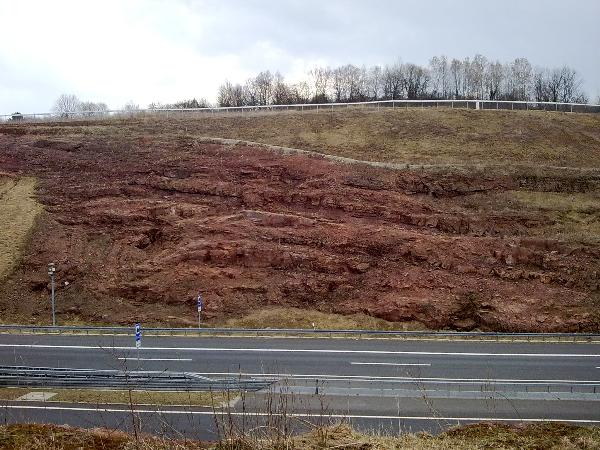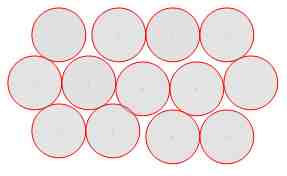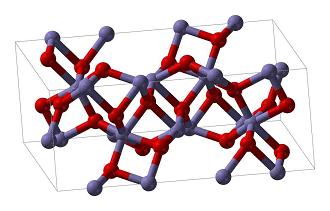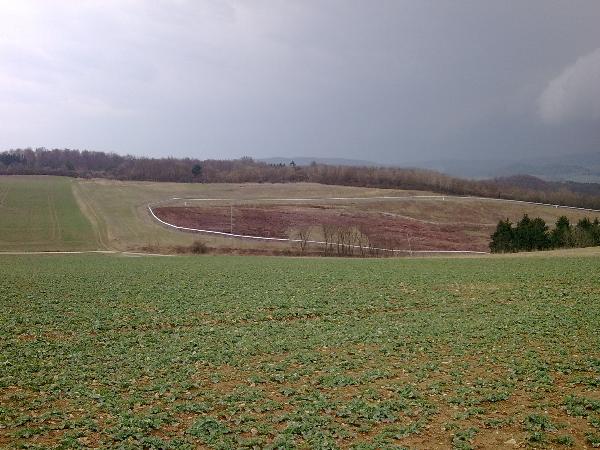Chemie des Buntsandsteins: Aufschluss am Heidkopf EarthCache
Chemie des Buntsandsteins: Aufschluss am Heidkopf
-
Difficulty:
-

-
Terrain:
-

Size:  (not chosen)
(not chosen)
Please note Use of geocaching.com services is subject to the terms and conditions
in our disclaimer.
Die Chemie des Buntsandsteins: Aufschluss am Heidkopftunnel

An den gegebenen Koordinaten findet ihr einen der neuesten Buntsandsteinaufschlüsse in Europa von beeindruckender Größe. Während die meisten der kleinen Buntsandsteinbrüche der Region schon vor Jahrhunderten aufgegeben worden sind und inzwischen durch zahlreiche Moose übergrünt und verwittert sind, kann man hier die imposante Farbintensität des bunten Sandsteines noch fast unverändert wahrnehmen.
1)Wie ist dieser Sandstein entstanden?
2)Wieso ist er rot?
3)Warum ist er an manchen Stellen weiß?

Dieser EC hat zum Ziel diese drei Fragen zu beantworten:
1) Wie ist dieser Sandstein entstanden?
Grundsätzlich gibt es drei Arten von Gestein:
a) Magmatische Gesteine (Magmatite) sind Gesteine, die durch vulkanische Aktivität entstanden sind; z.B. Basalt.
b) Sedimentgesteine (Sedimentite) sind Gesteine, die durch Ablagerungsprozesse (Sedimentation) gebildet wurden; z.B. Kalkstein (CaCO3).
c) Metamorphe Gesteine (Metamorphite) sind Gesteine, die durch hohen Druck oder hohe Temperatur umgewandelt wurden; z.B. Marmor, der ebenfalls aus CaCO3 besteht.
Sandstein gehört zu den Sedimentgesteinen b).
Er besteht, wie sich aus dem Namen schon ableiten lässt, aus kleinsten Sandkörnern (SiO2)(weiß-grau), die sich einst auf dem Meeresgrund oder in Flussläufen befanden. Diese Sandkörner lagerten in einer so genannten “Kugelpackung” an. Zur besseren Vorstellung beachte man die Grafik:

In den Hohlräumen zwischen diesen Sandkornkugeln befand sich Wasser. Im Laufe der Zeit und durch klimatische Änderungen wurden andere Sedimente auf dem Sand abgelagert. Dies führte zu einem hohen Druck, der in Kombination mit hohen Temperaturen in tieferen Erdschichten bewirkte, dass die einzelnen Sandkörner zu einem Gestein “zusammengepresst” wurden. Dadurch entwich aus den Zwischenräumen ein Großteil des Wassers, der darin gelöste Kalk (CaCO3) kristallisierte und verband die Sandkornkugeln wie ein Kleber (Zement genannt) zu einem Festkörper, dem Sandstein. Diesen Vorgang nennt man Diagenese.
Neben dem Kalk kommen auch noch diverse andere Silikate oder Tonminerale als Zement in Frage, sodass nicht nur der Anteil des Zements, sondern auch dessen Art die Eigenschaften des entstandenen Sandsteins maßgeblich beeinflussen. Da Kalk durch Säure gelöst wird (CaCO3 + 2H+ → Ca2+ + CO2 + H2O), sind carbonatische Sandsteine z.B. sehr anfällig gegen sauren Regen und werden daher heute i. d. R. nicht mehr für Hausbauten eingesetzt. War bei der Entstehung des Sandsteins nur eine geringe Menge an Zement anwesend, blieben große luftgefüllte Poren übrig und der Sandstein ist entsprechend porös und “bröselig”.
2) Wieso ist er rot?
Rote Farbe entsteht in der Natur meistens durch Eisenverbindungen (Bekannt z.B. sind die roten Blutkörperchen, deren rote Farbe durch das eisenhaltige Hämoglobin verursacht wird). Eine solche Eisenverbindung liegt auch beim Buntsandstein vor: Das fast wasserunlösliche Hämatit (Fe2O3) kristallisierte während der Diagenese ebenfalls und bildete eine dünne Schicht um die einzelnen weißen/farblosen Sandkörner (siehe oben), sodass heute der gesamte Sandstein rot erscheint.

Elementarzelle des Hämatits: Eisenatome (rot) und Sauerstoffatome (blau)
3) Warum ist er an manchen Stellen weiß?
Oft ist zu beobachten, dass Sandstein an einigen Stellen weiße Flecken oder Linien aufweist. Diese so genannten Reduktionshöfe sind der Beweis, dass es zu der Zeit, als der Sandstein noch als Sand im Fluss oder Meer lag, auch Pflanzen und Lebewesen gegeben haben muss. Sie bildeten beim Verrotten verschiedenste organische Materialien, die wie alle organischen Materialien größtenteils aus Kohlenstoffatomen in verschiedenster Zusammensetzung bestehen / bestanden haben.
Eingeschlossen in den Sandschichten reagierte der Kohlenstoff mit Hämatit. Dabei wurde im Hämatit das dreiwertige Eisenion zu einem zweiwertigen reduziert und der Kohlenstoff zu Kohlenstoffdioxid oxidiert. Da die entstandenen zweiwertigen Eisenverbindungen wasserlöslich waren, wurde sie über das in den Poren/Zwischenräumen befindliche Wasser ausgeschwemmt. Die roten Sandkörner entfärbten sich und blieben weiß zurück.





Logbedingungen:
1) Mache ein Foto (nach den neuen Guidelines optional) von dir/deinem GPS und dem Sandsteinaufschluss bei den angegebenen Koordinaten und lade es im anschließenden Log hoch. Fotos aus fahrenden Autos heraus werden aus sicherheitstechnischen Gründen nicht akzeptiert und führen zu einer unmittelbaren Löschung des Logeintrags. Ich hoffe dabei auf euer Verständnis.
2) Löse eine der folgenden mit A), B) und C) benannten Aufgaben!
A)
Folgende Reaktion lief bei der Bildung der Reduktionshöfe ungefähr ab:
2 Fe2O3 + C → 4 FeO + CO2
Um welchen Typ einer chemischen Reaktion handelt sich? Die Antwort findet man nicht vor Ort. Hier ist chemisches Grundlagenwissen gefragt.
Schicke mir die Antwort und du erhältst so schnell es geht eine Logerlaubnis. |
Für die alternativen Aufgaben B) und C) brauchst du ein kleines Stück Buntsandstein. Wenn du an den Koordinaten keinen erreichst, geh 20m Meter bergab zu einem senkrechten Rohr bei
Fundstelle 1
51° 23.975 N
009° 58.834 E
An dessen Fundament befinden sich diverse kleine Bruchstücke.
Oder gehe rund 150m weiter zu:
Fundstelle 2
51° 23.902 N
009° 59.117 E
In dieser Ecke des Ackers befinden sich besonders viele kleine Buntsandsteine. Nebenbei hat man auch einen hervorragenden Blick auf den Aufschluss und Fernsicht!
B)
Bewerte den Zementgehalt:
Versuche dazu ein Stück Buntsandstein durchzubrechen. Mache ein Foto davon. Bewerte danach, ob du den Zementgehalt im Sandstein für hoch, mittel oder niedrig hältst, und schick mir die Antwort. Du erhältst so schnell wie möglich eine Logerlaubnis. Im Log dann bitte das Foto zusätzlich hochladen. |
C)
   (Aufgabe für Earthcache-Helden - Die Bearbeitung dieser Aufgabe wird mit einem Eintrag in der cache-eigenen Hall of Fame honoriert!) (Aufgabe für Earthcache-Helden - Die Bearbeitung dieser Aufgabe wird mit einem Eintrag in der cache-eigenen Hall of Fame honoriert!)  
Beweise, dass tatsächlich Kalk als Zement in diesem Sandstein vorliegt!
Nimm dir dazu ein erbsengroßes Krümelchen Sandstein mit nach Hause und lege es eine halbe Stunde (länger schadet auch nicht) im Saft einer frisch gepressten Zitrone ein. Mache ein Foto vom Experiment und dir/deinem GPS. Was siehst du / hörst du (Ohr direkt dran halten - sehr leise) in den ersten Minuten, nachdem du den Sandtein in den Zitronensaft gegeben hast? Beschreibe (a) das Gesehene und (b) das Gehörte in einer Mail an mich und (c) erkläre es! Du erhältst so schnell wie möglich eine Logerlaubnis. Sollten die Beobachtungen und die Erklärung richtig sein, wirst du bei nächster Gelegenheit in die Hall of Fame aufgenommen.
Das Foto vom Experiment bitte im Log zusätzlich hochladen.

|
Wegbeschreibung:
Parken könnt ihr am Rande des Feldweges bei N 51° 24.136, E 009° 57.920. Folgt von dort der befestigten Straße in Richtung der Zielkoordinaten. Die Wegstrecke bis dahin ist 1,2 km lang, durchgehend befestigt und befahrbar, aber im letzten Stück etwas steiler. Daher nur bedingt rollstuhltauglich. Immer auf der Nordseite der Autobahn bleiben - an der Gabelung nicht durch die Unterführung gehen! Unterwegs kommt man am Traditional Cache Sehen und gesehen werden! vorbei.
Weiterführende Literatur:
Georgi: Kreislauf der Gesteine, Reinbek 1976.
Hollemann/Wiberg: Lehrbuch der anorganischen Chemie, Berlin 2007.
Viel Spaß wünscht
Miraculix84
PS: Besucht auch unbedingt den Tradi Drei Länder Blick - der dritte in knapp 200m Entfernung von den Zielkoordinaten. Die Aussicht ist fantastisch und, wenn man eh’ schon mal hier ist, sollte man sich den nicht entgehen lassen.

Blick von Drei Länder Blick - der dritte auf den Aufschluss. Keine Sorge, das Gewitter ist inzwischen abgezogen  .
.







Chemistry of bunter: Outcrop at Heidkopftunnel

At the coordinates shown above, there is a recent outcrop of bunter, which has an amazing size. As most of the region’s bunter stone quarries were abandoned some centuries ago and were meanwhile overgrown by moss and weathered, here the impressiv colour of bunter can still be observed.
1)How did this bunter come into existance?
Why is it red-coloured?
Why are there white areas in the red bunter?

It’s this earthcaches aim, to answer these 3 questions:
1) How did this bunter come into existance?
Generally there are three different types of rock:
a) Magmatic one, which came into existance by volcanos; f.e. basalt.
b) Sedimentary rock, which were generated by accumulation; f.e.limestone (CaCO3)
c) Metamorphous rock, which were turned into their actual modification by high pressure or temperature, f.e. marble, which consists of CaCO3, too.
Bunter is a sedimantary rock.
It consists of smallest pieces of sand (SiO2)(white or grey), which were located on the ground of oceans or rivers once. These grains of sand had been seated in sphere packing. To explain this easierly have a look at the picture below:

The gaps between the grains of sand were filled with water. Over the centuries and because of a change of weather conditions other sediments were deposited. This caused an enormous pressure and in conjunction with high temperature from the inner spheres of the earth, the single grains were compressed. So the water, which had filled the gaps before, oozed out, the lime (CaCO3) crystallised.and connected the single grains of sand just like glue. So bunter came into existance. All in all this transaction is called diagenesis. But limestone is not the only kind of glue (called cement); grains of sand in bunter can also be connected by several clay minerals or silicates. So the characteristics of bunter doesn’t depend only on the amount of cement, but also on kind of cement. As lime is solved by acids, (CaCO3 + 2H+ → Ca2+ + CO2 + H2O), bunter containing lime is vulnerable to acid rain and not used for building houses anymore. If there was only very few cement, when bunter was developed, it couldn’t fill the gaps between the grains comletely, so that bunter contains large pores filled with air. In this case, bunter is very cavernous and can be broken easily.
2) Why is bunter red coloured?
In nature most kinds of red colours are caused by compounds of iron. (Well known, f.e. are the red blood cells (erythrocytes). Their colour is caused by haemoglobin). In bunter, there is such a compound of iron, too: The water-insoluble haematite (Fe2O3) crystallised by diagenesis, too and formed a very thin, red layer around every grain of sand (see above). That makes bunter appear red coloured nowadays.

Elementary cell of haematite: Fe3+(red) and O2- (blue)
3) Why are there white areas in the red bunter?
These areas are caused by a chemical reduction and prove, that there had been organic life, when bunter developed: Organic material - any kind of animals or plants - sank down and was implemented into the sand. After many years, as any organic material consists of carbon, this carbon was oxidised by haematite. Carbon became carbon dioxid and disappeared, iron ions in haematit, which had three positive charges (Fe3+) were reduced to ions of two positive charges (Fe2+) and became soluble. So haematit disappered, too and white grains of sand remained, because their colour had gone.





Conditions to log:
1) Take a photo of you/your GPS at the coordinates shown above to prove your presence, if you like. Photos having been taken out of a moving car cannot be accepted, as they could possibly endanger other traffic. Logs with these kinds of pictures will be deleted immediately. Please be appreciative of this condition! Thank you!
2) Perform ONE of the following tasks, numbered with A), B) and C).
A)
The following reaction caused the white zones in the red bunter approximately:
2 Fe2O3 + C → 4 FeO + CO2. Which specific type of chemical reaction is it? The answer cannot be found on the ground. A basic knowledge of chemistry is needed.
Send the answer to me and you will receive the permission to log as soon as possible. |
For task number B) and C) you need a small piece of bunter. If you cannot find any at the coordinates shown above, go to
Fundstelle 1:
N 51° 23.975
E 009° 58.834
(20m). There is an upright pipe. At its grounding there are several flinders.
Or take a walk of approximately 150m to
Fundstelle 2:
N 51° 23.902
E 009° 59.117
At this corner of the acre there are many flinders of bunter, too. Additionally you will have a great view to the outcrop and the south of lower saxony.
B)
Evaluate the content of cement in bunter!
To do that, try to break a piece of bunter apart and take a picture. What do you think: Is the content of cement in this outcrop of bunter high, low or something between?
Send the answer to me and you will receive the permission to log as soon as possible. Please upload this picture in your log, too. |
C)
Examine the kind of the cement in bunter!
   (This is a task for heroes of earthcaching! Having performed this task you will be honoured by being enumerated in this cache’s HALL OF FAME!) (This is a task for heroes of earthcaching! Having performed this task you will be honoured by being enumerated in this cache’s HALL OF FAME!)  
Prove, that this bunter’s cement is limestone indeed.
To do this, take a small piece of bunter (about as big as a pea) home with you and put it into the juice of a freshly squeezed lemon. Take a photo of your experiment! What do you see and hear (take it as near as possible to your ear, as the sound is very silent!) in the space of a few minutes after having put the bunter into the juice? Send me an email describing, what you have seen (a), what you have heard (b) and explaining it (c). You will get the permission to log as soon as possible. If (a), (b) and (c) should be answered correctly, you will became member of this caches HALL OF FAME! Nevertheless, please upload the photo of your experiment in your log.

|
How to get to this earthcache: You can leave your car at the parking coordinates
N 51° 24.136, E 009° 57.920 . Follow the farm track in the direction of the cache’s coordinates. The distance is about 1,2km, but the way is continously paved and driveable. As the last 100m are quite ardous, the access by wheelchair, well, ... is not recommended. Please stay north of the highway. You don’t have to cross it. On your way you will pass the traditional Cache Sehen und gesehen werden!.
Further literature:
Georgi: Kreislauf der Gesteine, Reinbek 1976.
Hollemann/Wiberg: Lehrbuch der anorganischen Chemie, Berlin 2007.
Have fun
Miraculix84
PS: Please visit the traditional Cache Drei Länder Blick - der dritte , too. It’s not far away from the earthcaches coordinates - just 200m - and the scenic view is amazing!

View to the outcrop. Picture taken at Drei Länder Blick - der dritte.




by freeiconsweb.com
HALL OF FAME











Zitrone © by André Karwath
Additional Hints
(No hints available.)